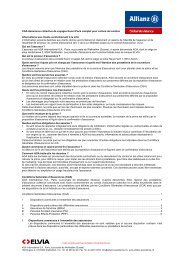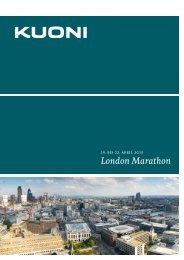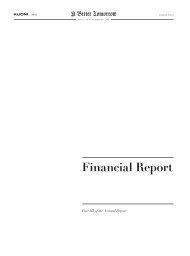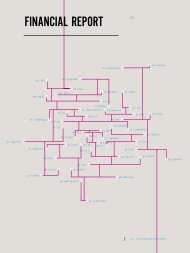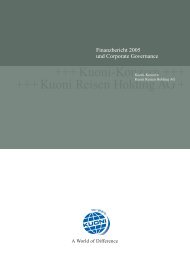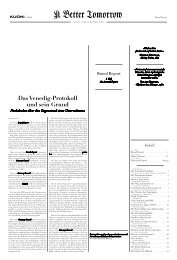Financial Report 2003 (english) PDF ⢠287.26 KB - Kuoni Group
Financial Report 2003 (english) PDF ⢠287.26 KB - Kuoni Group
Financial Report 2003 (english) PDF ⢠287.26 KB - Kuoni Group
You also want an ePaper? Increase the reach of your titles
YUMPU automatically turns print PDFs into web optimized ePapers that Google loves.
36<br />
Annex<br />
26. Derivative <strong>Financial</strong> Instruments<br />
In the normal course of its business, the <strong>Group</strong> is exposed to market, credit, interest rate, currency and fuel price risks.<br />
To manage these risks, various derivative financial instruments are used. While these are subject to the risk of<br />
market rates changing subsequent to acquisition, such changes are generally offset by opposite effects on the items<br />
being hedged.<br />
Credit Risk<br />
Exposure to credit risk is monitored on an ongoing basis and covered by appropriate value adjustments on accounts<br />
receivable and prepayments made.<br />
The counterparties to transactions in securities, derivative financial instruments and cash are carefully selected financial<br />
institutions. Given their high credit ratings, management does not expect any counterparty to fail to meet its obliga-<br />
tions. The maximum exposure to credit risk is represented by the carrying amount of each financial asset, except for<br />
foreign currency options.<br />
Interest Rate Risk<br />
The <strong>Group</strong> is exposed to interest rate risk as a result of movements in interest rates in the capital market. Generally, all<br />
long-term financial liabilities are fixed-interest bearing liabilities. Consequently, changes in interest rates can result in fluc-<br />
tuations in the fair value of such financial liabilities. This would not have any impact on net result or future cash flow,<br />
however. No such derivatives were outstanding as at the balance sheet date.<br />
Foreign Currency Risk<br />
The <strong>Group</strong> incurs foreign currency risk primarily on purchases and borrowings denominated in a currency other than<br />
the measurement currency of the respective subsidiary. Significantly smaller is the amount of sales denominated in<br />
a currency other than the measurement currency of the respective subsidiary. On a consolidated basis, the <strong>Group</strong> is also<br />
exposed to currency fluctuations between the Swiss franc and the local measurement currencies of its subsidiaries.<br />
The major currencies giving rise to currency risk are the euro, pound sterling and US dollar.<br />
The <strong>Group</strong> uses forward exchange contracts, currency options and swaps to hedge its foreign currency risk. Most hedging<br />
contracts have maturities of up to 12 months. Where necessary, the forward exchange contracts are rolled over at<br />
maturity. The <strong>Group</strong> does not hedge for its net investment in foreign entities and the related foreign currency translation<br />
of local earnings.<br />
The currency hedging contracts outstanding on the balance sheet date are summarised in the following table. Gains and<br />
losses on hedge contracts qualifying as cash flow hedges are expected to be removed from shareholders’ equity within<br />
12 months. Changes in the fair value of forward exchange contracts, currency options and swaps that economically<br />
hedge monetary assets and liabilities in foreign currencies and for which no hedge accounting is applied are recognised<br />
in the income statement. Both the changes in fair value of the forward contracts and the foreign exchange gains and<br />
losses relating to the monetary items are reported under direct costs.






